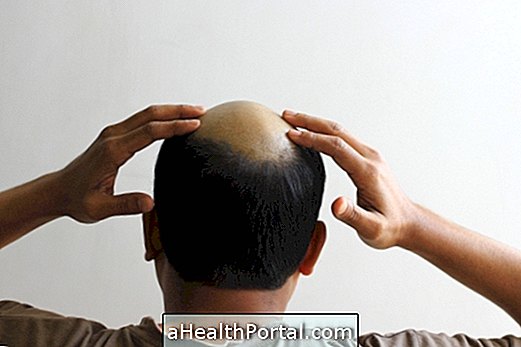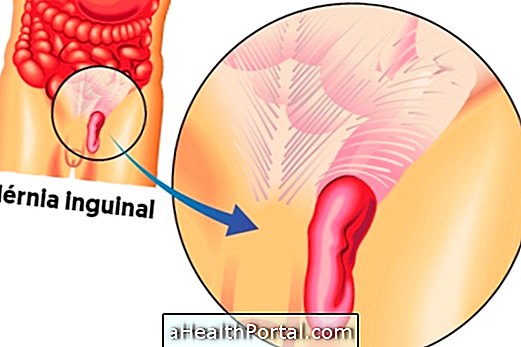Hair transplantation is a surgical procedure that aims to fill the area without hair with the person's own hair, either the neck, chest or back. This procedure is usually indicated in cases of baldness, but can also be done in cases of hair loss due to accidents or burns, for example. Learn what can make hair fall.
In addition to treating the lack of hair on the scalp, the transplant can also be done to correct eyebrow or beard failure.
Transplantation is a simple procedure performed under local anesthesia and sedation, which guarantees long-lasting and satisfactory results. Depending on the area to be filled and the technique to be used, the hair transplant can cost between R $ 5000 and R $ 30, 000, and can be done on a day or two consecutive days, when the area is larger.

How is done
The hair transplantation can be done by means of two techniques, FUE or FUT:
- FUE, or Follicular Unit Extraction, is a technique that consists of removing the follicles one by one with the aid of surgical equipment, and also implants one by one directly into the scalp, for example, being ideal for treating small areas without hair . This technique can also be performed by a robot operated by an experienced professional, which makes the procedure more expensive. However, the recovery is faster and the scars are less visible and the hair covers them easily;
- FUT, or Follicular Unit Transplantation, is the technique best suited to treat larger areas and consists of the removal of a scalp strip, usually from the nape of the neck, in which follicular units are selected that will be placed on the scalp in small holes that are made in the area receiving the transplant. Although it is a bit cheaper and faster, this technique leaves a scar a little more visible and the rest time is greater, only being allowed to return to physical activities only after 10 months of performing the procedure.
Both techniques are very efficient and guarantee satisfactory results, it is up to the doctor to decide with the patient the best technique for the case.
Usually the hair transplant is done by a dematological surgeon under local anesthesia and light sedation and can last between 3 and 12 hours, depending on the size of the area that will receive the transplant, and in the case of very large areas, the transplant is performed on two consecutive days.
Preparation for transplantation
Before transplantation the doctor should request a series of tests to evaluate the general health of the person, such as chest X-rays, blood count, echocardiogram and coagulation, which is done to verify the person's blood clotting capacity and thus verify the risks of bleeding.
In addition, it is recommended to avoid smoking, consume alcohol and caffeine, cut hair and use anti-inflammatories such as Ibuprofen or Aspirin, for example. It is also recommended to protect the scalp to avoid burns and to wash the head thoroughly.

How is the postoperative period?
After transplantation it is normal that the person has no sensitivity in the area that the follicular units were removed and in the area where the transplant was performed. For this reason, the doctor can recommend the use of medicines to relieve the pain, as well as prevent the transplanted area from being exposed to the sun, to avoid burns, and wash the head at least 3 times a day with a specific shampoo or according to with medical advice.
If the transplant was done with the FUE technique, the person can return to the routine, including exercise, 10 days after the transplant, as long as he does not do activities that put a lot of pressure on the head. On the other hand, if the technique was FUT, it may be necessary for the person to be at rest, without performing exhausting activities, for about 10 months.
The risk of hair transplantation is the same as any other surgical procedure, and there may be an increased risk of infection, chance of rejection or bleeding. However, when carried out by a qualified and experienced professional, the risks are minimized.
When the hair transplant is indicated
Hair transplantation is usually indicated in case of baldness, however it can also be indicated in other cases, such as:
- Alopecia, which is the sudden and progressive loss of hair from any part of the body. Learn more about alopecia, causes and how treatment is done;
- Trichotillomania, which corresponds to the mania of plucking the hair. Here's how to identify and cure trichotillomania;
- Loss of hair due to burns or accidents;
- Hair loss due to surgical procedures.
Hair loss is caused by a number of factors, and may be due to aging, hormonal changes or genetics. The transplant is only indicated by the doctor if the person has a good amount of hair in the potentially donor area and is in good health.
Difference between transplantation and capillary implant
The capillary implant is usually used as a synonym for hair transplantation, however, the word implant usually refers to the placement of artificial hair strands, which can cause rejection and be necessary to perform the procedure again. For this reason, the hair implant almost always refers to the same hair transplant procedure: placing hair from the person in a region where there is no hair. As with the placement of artificial wires, transplantation between two people can also cause rejection, and this is not indicated. Know when to do the hair implant.






















